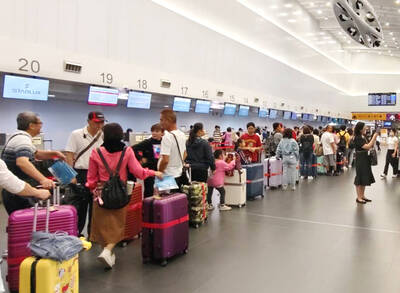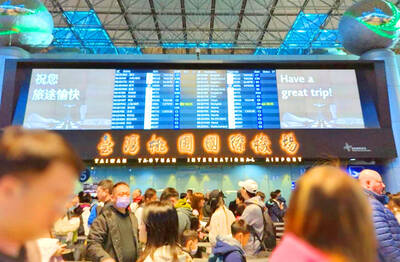More than 100 paintings on tree bark by Australian Aborigines are on display in Taipei.
The Old Masters: Australia’s Great Bark Artists — 134 works of mostly tree bark paintings and clay figurines — opened on Friday at the National Taiwan Museum in Zhongzheng District (中正).
The works come primarily from the Arnhem Land region of Australia’s Northern Territory, the traditional home of the Yolngu people, said Margo Neale, senior curator of the Indigenous Knowledge Centre at the National Museum of Australia, which helped organize the exhibition.
“It is a very highly sophisticated way of passing on culture that survives today. These bark paintings are like messages on note paper, where you write information to tell other people things,” Neale said.
The paintings are like encyclopedias, because they hold the identity of the artist, she said, adding that if a person is knowledgeable enough, they can see the information embedded in the paintings.
Neale said that Djan’kawu Cross Back to the Mainland, painted by Djunmal in 1966, describes a mythical story of two sisters who came to Australia and dug holes in to provide the land with irrigation water.
“If you look, you can see the water holes and the digging sticks, and all of these different patterns refer to salt or fresh water and mud plains,” Neale said. “So it’s a geographical map of a particular coast at the top of Australia.”
The Aboriginal communities of Taiwan and Australia have closely related anthropology and genetics, Deputy Minister of Culture Hsiao Tsung-huang (蕭宗煌) said.
“The National Taiwan Museum and the National Museum of Australia are extremely proud to present this exhibition with the highest respect to Aboriginal communities,” he said.
When the exhibition ends on Feb. 9 next year, the works of art are to be returned to Australia.

Three Taiwanese airlines have prohibited passengers from packing Bluetooth earbuds and their charger cases in checked luggage. EVA Air and Uni Air said that Bluetooth earbuds and charger cases are categorized as portable electronic devices, which should be switched off if they are placed in checked luggage based on international aviation safety regulations. They must not be in standby or sleep mode. However, as charging would continue when earbuds are placed in the charger cases, which would contravene international aviation regulations, their cases must be carried as hand luggage, they said. Tigerair Taiwan said that earbud charger cases are equipped

Foreign travelers entering Taiwan on a short layover via Taiwan Taoyuan International Airport are receiving NT$600 gift vouchers from yesterday, the Tourism Administration said, adding that it hopes the incentive would boost tourism consumption at the airport. The program, which allows travelers holding non-Taiwan passports who enter the country during a layover of up to 24 hours to claim a voucher, aims to promote attractions at the airport, the agency said in a statement on Friday. To participate, travelers must sign up on the campaign Web site, the agency said. They can then present their passport and boarding pass for their connecting international

Temperatures in northern Taiwan are forecast to reach as high as 30°C today, as an ongoing northeasterly seasonal wind system weakens, the Central Weather Administration (CWA) said. CWA forecaster Tseng Chao-cheng (曾昭誠) said yesterday that with the seasonal wind system weakening, warmer easterly winds would boost the temperature today. Daytime temperatures in northern Taiwan and Yilan County are expected to range from 28°C to 30°C today, up about 3°C from yesterday, Tseng said. According to the CWA, temperature highs in central and southern Taiwan could stay stable. However, the weather is expected to turn cooler starting tonight as the northeasterly wind system strengthens again

Taiwan sweltered through its hottest October on record, the Central Weather Administration (CWA) said yesterday, the latest in a string of global temperature records. The main island endured its highest average temperature since 1950, CWA forecaster Liu Pei-teng said. Temperatures the world over have soared in recent years as human-induced climate change contributes to ever more erratic weather patterns. Taiwan’s average temperature was 27.381°C as of Thursday, Liu said. Liu said the average could slip 0.1°C by the end of yesterday, but it would still be higher than the previous record of 27.009°C in 2016. "The temperature only started lowering around Oct. 18 or 19